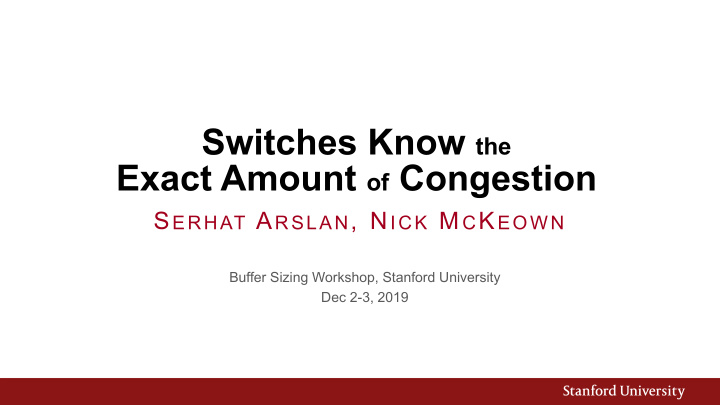



Switches Know the Exact Amount of Congestion S ERHAT A RSLAN , N ICK M C K EOWN Buffer Sizing Workshop, Stanford University Dec 2-3, 2019
Main Takeaways 1. We should directly measure the cause of congestion. 2. Congestion is buildup of the queue at a bottleneck link. 3. Switches today can provide their buffer occupancy freely. 4. Bottleneck buffer occupancy can be collected by updating a header field on packets. Serhat Arslan, sarslan@stanford.edu
Serhat Arslan, sarslan@stanford.edu
Serhat Arslan, sarslan@stanford.edu
Why don’t switches simply tell everything? Measure the congestion directly at the location of congestion itself… Serhat Arslan, sarslan@stanford.edu
Congestion Signal on TCP Header Serhat Arslan, sarslan@stanford.edu
Construct Your Custom Signal 𝑟 = 𝑟 2 , … , 𝑟 56 , 𝑥ℎ𝑓𝑠𝑓 𝑙 ≅ ℎ𝑝𝑞_𝑑𝑝𝑣𝑜𝑢 𝟑𝒍 𝒓 𝒋 𝒈( 𝒓 ) = 𝜥{ ∃ 𝒋 𝒓 𝒋 > 𝒖𝒊𝒔𝒇𝒕𝒊 } 𝒈( 𝒓 ) = ∑ 𝒋E𝟐 RTT ECN 𝟑𝒍 𝒓 𝒋𝟑 𝒈 𝒓 = 𝒏𝒃𝒚( 𝒓 ) ∑ 𝒋E𝟐 𝒈( 𝒓 ) = Bottleneck! Serhat Arslan, sarslan@stanford.edu
Effectiveness Analysis Ablation Scenario: Serhat Arslan, sarslan@stanford.edu
Effectiveness Analysis Serhat Arslan, sarslan@stanford.edu
Feasibility Analysis Overhead Costs: Latency Throughput NOPQ RST ≈ 0.4% of MTU Enough to collect 8 M Serhat Arslan, sarslan@stanford.edu
Main Takeaways 1. We should directly measure the cause of congestion . 2. Congestion is buildup of the queue at a bottleneck link . 3. Switches today can provide their buffer occupancy freely. 4. Bottleneck buffer occupancy can be collected by updating a header field on packets. Serhat Arslan, sarslan@stanford.edu
Questions? S E R H A T A R S L A N s a r s l a n @ s t a n f o r d . e d u
Recommend
More recommend